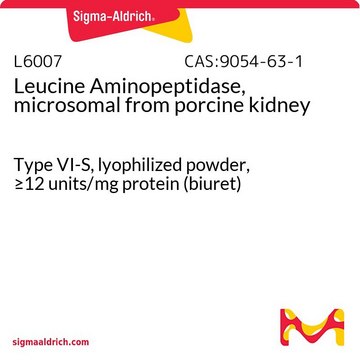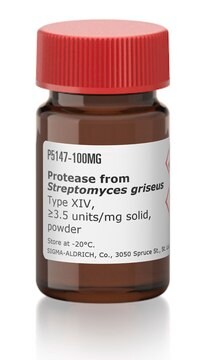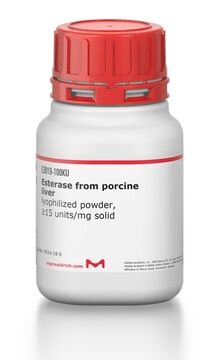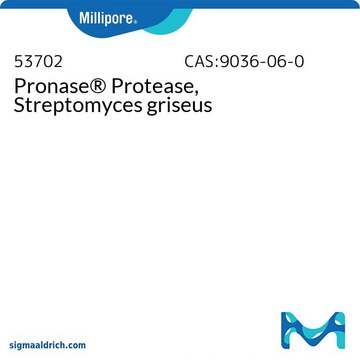P6675
Prolidase from porcine kidney
lyophilized powder, ≥100 units/mg protein
Sinonimo/i:
Aminoacyl-L-proline hydrolase, Imido Dipeptidase, Prolidase, Proline dipeptidase
Autenticatiper visualizzare i prezzi riservati alla tua organizzazione & contrattuali
About This Item
Prodotti consigliati
Stato
lyophilized powder
Attività specifica
≥100 units/mg protein
Composizione
Protein, 20-74% Lowry
Temperatura di conservazione
−20°C
Cerchi prodotti simili? Visita Guida al confronto tra prodotti
Categorie correlate
Descrizione generale
Prolidase is a cytosolic exopeptidase. It is a homodimeric enzyme which requires divalent cations like manganese as a cofactor in its active site for its function.
Applicazioni
Prolidase from porcine kidney has been used:
- in the enzymatic hydrolysis of porcine milk for the recovery of L-glutamine from proteins and peptides
- in the proteolysis of skim milk for the determination of ε-(γ-glutamyl)lysine and free aminoacids
- to determine its effect on the activity of enterococcin A 2000
Prolidase has an important role in recycling of proline and collagen production. It is used to study mutations in the PEPD gene that cause prolidase deficiency. It is used to hydrolyze proteins with C-terminal proline or hydroxyproline residues. Prolidase, product P6675 from porcine kidney, has been used to hydrolyze peptide bonds from the amino terminus when studying enzymatic methylation of membrane proteins.
Azioni biochim/fisiol
Prolidase is an enzyme that catalyzes the hydrolysis of the imide bond between an α-carboxyl group and proline or hydroxyproline. The protein forms a homodimer that hydrolyzes dipeptides or tripeptides with C-terminal proline or hydroxyproline residues.
Rare mutation in prolidase gene causes deficiency leading to massive imidodipeptiduria, elevated proline-containing dipeptides in plasma, recurrent infections, mental retardation and skin lesions.
Definizione di unità
One unit will hydrolyze 1.0 μmole of Gly-Pro per min at pH 8.0 at 40 °C.
Stato fisico
Supplied as a lyophilized powder containing Tris buffer salt and MnCl2.
Avvertenze
Danger
Indicazioni di pericolo
Consigli di prudenza
Classi di pericolo
Eye Irrit. 2 - Resp. Sens. 1 - Skin Irrit. 2 - STOT SE 3
Organi bersaglio
Respiratory system
Codice della classe di stoccaggio
11 - Combustible Solids
Classe di pericolosità dell'acqua (WGK)
WGK 1
Scegli una delle versioni più recenti:
Possiedi già questo prodotto?
I documenti relativi ai prodotti acquistati recentemente sono disponibili nell’Archivio dei documenti.
I clienti hanno visto anche
L-Glutamine or L-alanyl-L-glutamine prevents oxidant-or endotoxin-induced death of neonatal enterocytes
Haynes TE, et al.
Amino Acids, 37(1), 131-142 (2009)
Ertugrul Uzar et al.
Neurological sciences : official journal of the Italian Neurological Society and of the Italian Society of Clinical Neurophysiology, 33(4), 875-880 (2011-11-29)
We found no data in the literature related to oxidative stress index (OSI), total oxidative status (TOS) and prolidase activity in patients with diabetic neuropathy (DN). In this study, we aimed to evaluate the oxidative status of DN patients via
Prolidase
Namiduru, ES
Bratislavske lekarske Listy, 117(8), 480-485 (2016)
Casey M Theriot et al.
Archaea (Vancouver, B.C.), 2011, 565127-565127 (2011-12-14)
Prolidases hydrolyze Xaa-Pro dipeptides and can also cleave the P-F and P-O bonds found in organophosphorus (OP) compounds, including the nerve agents soman and sarin. Ph1prol (PH0974) has previously been isolated and characterized from Pyrococcus horikoshii and was shown to
I M Ota et al.
The Journal of biological chemistry, 264(22), 12879-12884 (1989-08-05)
A group of 23-29-kDa polypeptides in the membranes of bovine rod outer segments are substrates for S-adenosylmethionine-dependent methylation reactions. The bulk of the methyl group incorporation is in base-labile ester-like linkages, and does not appear to be due to the
Il team dei nostri ricercatori vanta grande esperienza in tutte le aree della ricerca quali Life Science, scienza dei materiali, sintesi chimica, cromatografia, discipline analitiche, ecc..
Contatta l'Assistenza Tecnica.

















